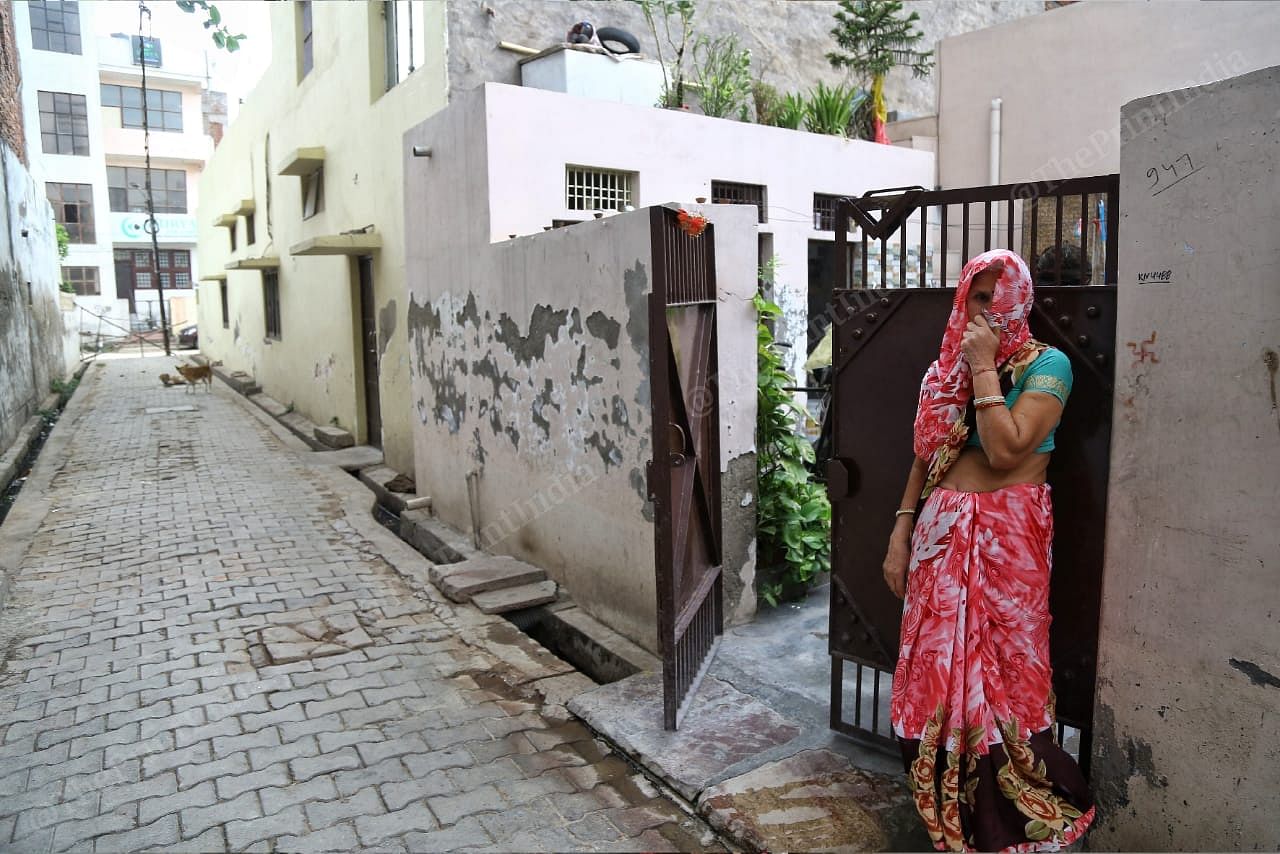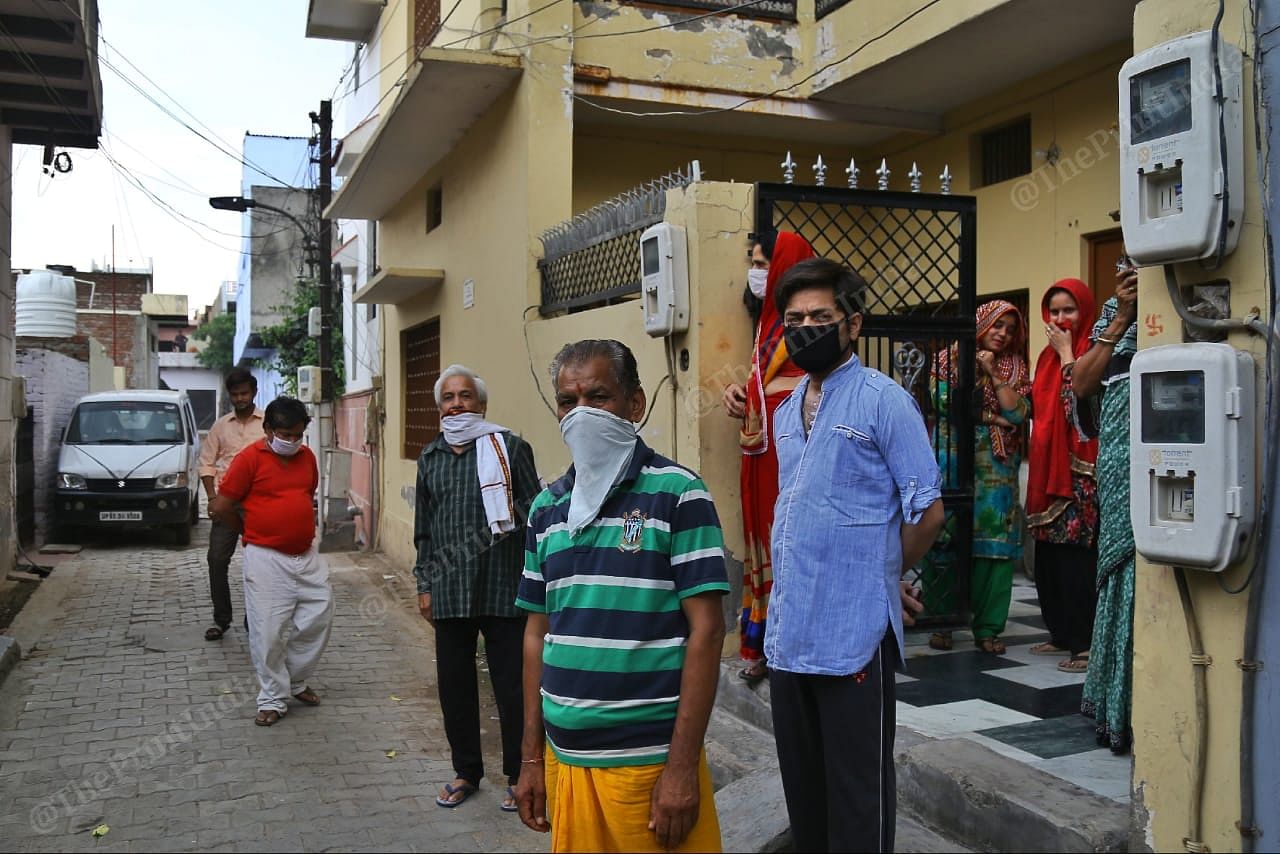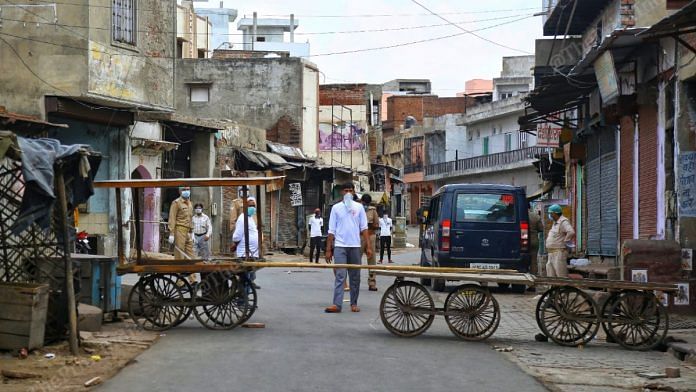Agra: The so-called ‘Agra model’ that the Yogi Adityanath government in Uttar Pradesh has talked about might be a success story in terms of containment, but for people living in the hotspots, it has been like living a nightmare.
Agra is among the country’s hotspots, with 468 active cases, 11 deaths and 69 recoveries as of Thursday.
Within the district, there are 32 hotspots which have been sealed, locking people in their homes without the luxury of going to the market for groceries and essentials that non-hotspot areas enjoy.
Residents claim that the containment zones have turned into traps where there is little to no access to groceries, essentials as well as Covid-19 testing facilities. They also alleged that the government, which is supposed to provide doorstep-delivery of essentials, has not been reliable. But their biggest grouse has been the lack of testing to ascertain just how prevalent the virus is in these areas.
ThePrint visited three of the 32 areas identified as hotspots by the Agra administration — Khatik Pada, Khandari and Kamla Nagar on 26 April.
Also read: UP’s ‘Agra model’ under scanner as Covid cases rise, govt says it’s due to increased testing
What is the Agra model?
The Agra district administration put in place an aggressive cluster containment strategy aimed at containing the disease within a defined geographical area by making early detections and breaking the chain of transmission. This has resulted in many areas being designated hotspots and cordoned off.
An area is declared a hotspot when a new case is recorded. These are designated into one of three zones: red, orange and green.
As long as new cases are reported within 14 days, the area remains in the red zone. If no new case is detected in two weeks, the area is moved to the orange zone. If no new cases are detected in 28 days, then the area is no longer a hotspot and is considered a ‘green zone’.
At this point, authorities take a call whether an area should continue with the strict restrictions.
Explaining the rationale, district magistrate Prabhu N. Singh told ThePrint, “There are 32 active hotspots in Agra currently. Wherever we find that the number of cases is more, we seal the area. We have to be more liberal in our approach, so more areas become hotspots or containment zones. This helps restrict movement and contain the spread of virus.
“This lockdown has been there for one month, to ensure people don’t go out for their daily needs and there is no movement, we have to keep a watch. We have been providing them essential services at their doorsteps,” he added.

The administration has used technology — from mobile phone GPS to drones and a web of CCTV cameras — to monitor the movement of infected people. The network is meant to keep an eye out for large gatherings and ensure food distribution among not just the needy, but also animals.
Also read: A war room, drones, CCTVs — how ‘hotspot’ Agra became Covid-19 model town
Ground reality
Residents in hotspot zones claim that the only effective part of the plan has been the strict lockdown.
In the Kamla Nagar area, people alleged that the water supply has been erratic, essential food items were not being provided, and despite requests for testing, no one has come forward so far.
“I personally know people who have made phone calls multiple times over several days asking for Covid-19 test, but nothing happened. There is simply no planning and we have been sealed without being given any essential services. Even for water and vegetables, we are struggling,” said Anmol, a resident in Kamla Nagar.

Before the lockdown, a priest managing a temple in the Khatik Pada area would collect food from residents praying at the temple. Since the lockdown, he has been finding it difficult to sustain himself. After the area was declared a hotspot, he barely manages one square meal a day.
“We should get ration, but we are not getting. I have been surviving by getting food from the residents. If the people will not come to mandir, how will I get food? The mandir is closed, so naturally when no one will come, how will they give food? I have been going from one house to another asking for food. People do give, but how long can they also sustain this,” said the priest, referring to the lack of groceries.
In the Khandari area too, people narrated a similar ordeal.
“Our area was declared a hotspot after one person in our colony tested positive. His house was sealed. I have been taking up the issue of sanitising the area with the administration but not much has happened. We are also not able to buy milk and vegetables. They should at least carry out testing to know others are not infected. Is this what is called the ‘Agra model’?” said Anurag who lives in the area.
Also read: Rs 3,000 crore and 4 lakh jobs, the price Agra tourism is paying for coronavirus
Testing and sanitisation
When an area is declared a red zone, the administration mobilises sanitisation efforts, which include mopping using fire brigade vehicles, a government official said.
However, residents allege that the sanitisation trucks that come are diverted by local councillors to their homes.
“The MP (Agra member of Parliament) has been sending sanitisation trucks for our areas but they are diverted to other places by the local leaders,” said a resident of Khandari area.
DM Singh said all cases reported so far in Agra have been from hotspots, the maximum of them being from close contacts. “We have been inspecting the areas and sanitising them too,” he added.
“We are getting sampling done and are increasing the number every day,” he added. On an average, 300 samples are taken for testing, he said.
However, administration efforts notwithstanding, residents say they are struggling and that the current situation is not sustainable for them.
In Khatik Pada, which has a number of vegetable vendors living there, people claim they are running out of money. With the government not providing sufficient ration, they are finding it difficult to sustain themselves.
“There are times when milk supply is provided by the administration but there are such long queues that maintaining social distancing becomes difficult. We have been sneaking out to other areas that are not in the red zone to get some food supplies but can we function like this?” said a resident.
Also read: 12-year-old dies of ‘stomach pain’ after 6 Agra hospitals refuse treatment over Covid scare




Mr karan Thaper difinitely u get regularly kick back from China & pak… For that i m sure…. 🤔